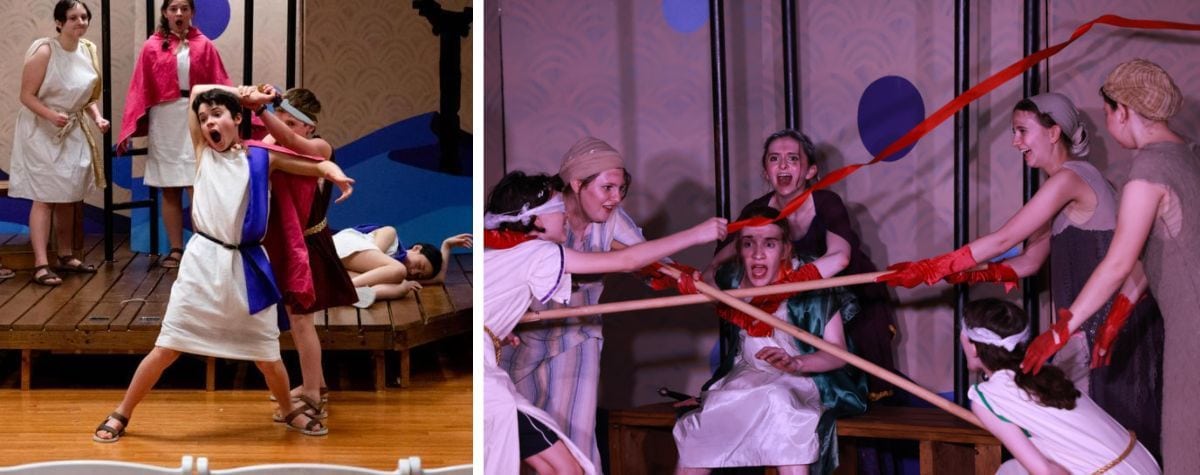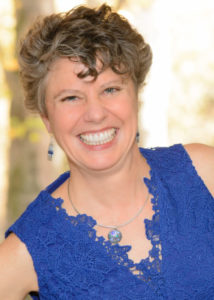By Jeanne Harrison, founder and producing artistic director, Traveling Players
It’s actually super fun to do a fight play. Fight scenes are the opposite of real violence: pieces of choreography that you rehearse like a dance with safety checks, trust, and close partner work. The victim is in charge. When done right, fight scenes allow actors and audiences to experience a violent action and all of its implications knowing that everyone is actually safe. At the end of a fight play, the victim and aggressor clasp hands and take a bow. It can be incredibly healing, cathartic, and educational for both the performers and the audience.

The ancient Greeks believed in the healing power of theater — it’s why they made attending theater a mandatory part of citizenship. Twice a year they held the Festival Dionysia, a ritual honoring the god of theater and wine, Dionysus. At the center of the festival was a playwriting competition. The rockstars of the day would submit tragedies about the downfall of great, heroic families. By witnessing their trials and follies, the audience would discover the pitfalls of being human and the traps we all succumb to. They would walk away wiser, perhaps able to forgive themselves, maybe even healed.
After two years of pandemic uncertainty, and with new conflicts brewing, our students needed a Dionysian Festival.
Ancient Greek myths tell epic stories and require a level of emotional commitment that is not typically asked of teenage actors. And yet, in some ways, it is teenagers — with their heightened emotions — who are best equipped to tell these narratives. In the wake of the pandemic, teenagers are grappling with the sorrow of all that they lost and the anger of not getting those experiences back. As the founder of Traveling Players, an educational company for children and teens, I started to wonder: What if we could channel that frustration? and release some of it?

After two years of classes taught on Zoom, and rent paid on a brand new studio that we were able to use for only two months before COVID closed it down, it only seemed right that the Traveling Players’ rebirth harkened back to theater’s birth — we would stage our very own Dionysian Festival.
As an educational theater company, our season selection always begins by asking what our students need. We want our plays to be engaging for our audiences, but to give our students appropriate, meaningful challenges. Allowing for maximum growth as performers and individuals is paramount. We want developing actors to engage with stories worthy of their imaginations.
For our youngest actors, in grades 4–7, we commissioned a play called Ariadne’s Thread by playwright Judith Walsh White, an exceptional playwright for young audiences and actors. Our oldest students (in grades 9–12) took on the ethically complicated tale of Euripedes’ Hecuba translated impeccably by Kenneth McLeish. Hecuba shows the emotional toll of war, investigating the cycles of violence that play out between people, generations, and nations — and especially the effects on women and children. If you’re a theater buff, this play is gold — it’s the violent combo of Medea and Oedipus, yet nobody knows the story, so they never see it coming. (Casey Kaleba, DC’s formidable fight choreographer and our collaborator since 2006, was eager to join our design team, remarking that he rarely gets to work on a good, bloody ancient Greek tragedy.)
Hecuba follows the sad tale of Trojan Queen Hecuba, beginning just after the Trojan War has ended. After 10 long years, the victorious Greeks will sail home with their war booty — which includes the women of Troy as their new possessions. Hecuba must endure the murder/blood-sacrifice of her daughter, then discover that her son was murdered by a neighboring King, a supposed ally. As she is wracked with despair, with nothing else to lose, the play becomes a cathartic revenge tragedy. Hecuba and the Trojan women blind the King who killed her son, then kill his two sons. The play ends as Hecuba and the remaining women prepare to leave their homes in Troy, now with blood on their hands, to begin a life of slavery in Greece.
“It’s fate. It’s hard,” says the Chorus as the play ends.

Like the pandemic, the violence in Hecuba is inescapable. While the Greeks traditionally kept the violence offstage, only described by witnesses and victims, I felt it was important (and more fun) to bring it onstage. This gave our students a chance to work really physically and collaboratively, with deep trust in their stage partners — the essence of ensemble theater.
To help audiences and the actors grapple with these difficult and emotionally fraught themes, we invited our friend American University Professor Barbara Wien to lead a post-show discussion. Professor Wien has worked to end human rights abuses, violence, and war. She is a practitioner-scholar with extensive knowledge of sustainable peace agreements and best practices in ending gender-based violence. Her many credits include working for the U.S. Institute for Peace and leading V-Day, the organization founded by Tony Award–winning actor and playwright V (formerly Eve Ensler) to end violence against women.
The Bronze era Greeks believed in “revenge justice,” where you enact the same level of pain against your aggressor that they enacted upon you. In discussing this concept with our students as it related to the themes of the play, one young performer, Silas Frickert, 14, summed it up sagely: “Hurt people will hurt people,” he said.
But there is no revenge justice to be had against a natural disaster like a pandemic. By trusting their castmates and this ancient story, our students took a leap of faith, channeled their grief, and released it into their performances. They began to heal. And they found joy in the fake (and often bloody) violence of the plays. They relished the chance to be physical again, and took on new artistic challenges (including puppetry, mask, and dance on top of stage combat) with focus and alacrity.
Our students needed to be in bloody good plays that scared them, excited them, and required them to push the boundaries of their skills. They needed to escape into someone else’s pain to be released from their own.
That is the catharsis of a Dionysian Festival, for performers and audience alike.
About the Festival
Traveling Players Dionysian Festival ran March 12–20, 2022. The festival was led by Jeanne Harrison, Traveling Players’ founder and artistic director, who also directed Hecuba. She received ArtsFairfax’s 2016 Strass Award for her integration of physical and classical theater. Previously a dancer-choreographer, she has led workshops on directing a Greek chorus for the American Alliance for Theater & Education as well as universities.

Recognized by the National Endowment for the Arts as “1 of 25 Summer Schools for the Arts,” Traveling Players trains students in grades 3–12. Students who are interested in getting involved can join classes year-round at Traveling Players’ studio in Tysons Corner Center, or over the summer at their residential camps and conservatory programs.
Auditions are now open for summer 2022 programs. Spring classes are now open for registration. For more information visit travelingplayers.org.

Jeanne E. Harrison (she/her) is the founder and producing artistic director of Traveling Players Ensemble and directs the summer’s Shakespeare Troupe and the winter Shakespeare in Performance class. She holds an MFA in directing from Catholic University, an MA in Theatre and Drama from the University of Wisconsin-Madison, and a BA in English from Macalester College. She has taught theater for The Folger Shakespeare Library, John Moores University (England), University of Maryland-Baltimore County, Catholic University and The Chapin School. She was a visiting artist at Loyola University in Baltimore.




